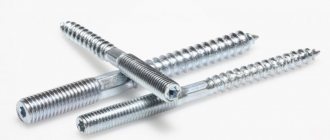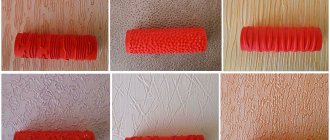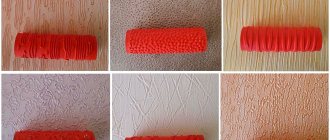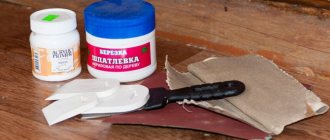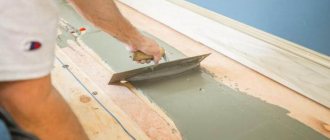Although a paint roller is a fairly simple tool, it has a large number of varieties, so you should choose it strictly according to certain criteria, since each type has its own purpose.
In this material we want to explain in detail what types of paint rollers there are, their sizes, and how to choose the right one for its intended purpose in a given case.
Introduction
Not every painter who takes a brush, but every painter takes a brush to work, however, this place of honor is increasingly being occupied by another tool. Today I use a paint roller to paint walls, ceilings, and even the whole house. It owes its popularity to its simplicity of design, large selection of models and versatility in operation.
Nowadays there is no master who does not have such an assistant in his toolkit. There really are no limits to its possibilities, because every year new types or additional modifications appear on store shelves that expand the range of possibilities or make the process more convenient.
What to look for when buying a paint roller?
When choosing a tool for painting work, you should proceed from the tasks that need to be solved with its help. It must be remembered that even between products made of the same material there are differences due to their quality.
- As a rule, tool manufacturers make rollers of various colors, which indicate the quality of the material. For example, foam coats can be colored blue, yellow or white, which corresponds to the density of the foam in descending order. Similar colors are used for instruments made from other materials.
Without solid painting experience, you should not choose a large paint roller. This will create inconvenience when using it, which will significantly reduce labor efficiency.
- It is advisable to purchase several rollers that can be installed on one machine. Thus, it becomes possible to apply various paints or paints of different colors to the surface. The fur coat should not have a clearly visible seam or protruding thread ends, as this indicates the low quality of the instrument. A poor-quality seam can lead to paint smudging during application.
- To be able to reuse the roller for several days, it must be placed in a plastic or plastic bag and then tied tightly.
- To increase the efficiency of using this tool, it is worth purchasing a cuvette - a special trough for painting work.
USEFUL INFORMATION: How to choose an iron entrance door for an apartment? Noise and heat insulation, lock and hinges
Roller arrangement
Therefore, it could be simpler than a paint brush, really nothing, but a roller is not only simpler, but more versatile and more durable. If the paint brush has become unusable, then a sad fate awaits it, but in the roller you can replace the damaged part or, in some types, even restore it . The tool itself consists of:
- yoke, curved handle;
- tube, rod on which the ink part rotates;
- bobbin, rotating cylinder with a fur coat.
In addition to these main parts, the tool can have in its design all kinds of extension cords, moisture removers, and so on. When talking about the sponge bobbin, the differences in the joints between them all depend on the type.
The fur coat can be glued and peeled off from the bobbin, be replaceable or welded together in production. Most often you can find the first two methods; they are the most profitable, because after use you can simply replace the worn sponge with a new one.
Selecting rollers by size
The classification of the instrument in question can also be carried out according to the length and diameter of the core. Let's take the following indicators as an example:
- Small or mini rollers have a core length from 50 to 100 mm, and the diameter does not exceed 15 mm. Area of application: painting hard-to-reach places. It is worth considering that such design options do not need to be used as a universal tool. This is due to the fact that when using them, a large number of strokes are formed, and the work of applying a large number of materials becomes more complicated. This category of painting tools is cheaper than others, so it is very popular.
- Medium ones have a roller length from 100 to 150 mm. This version of the instrument has become the most widespread, as it has a certain versatility. Can be used for painting both walls and canvas. Not suitable for complex surfaces that have a large number of edges and sharp corners, planes located at an angle. An acceptable price is combined with versatility of use.
- Large ones have a roller length from 180 to 270 mm. This version of the rollers is intended for professionals. Due to the large size, the cost of the tool increases significantly. A suitable container should be selected for this type of roller.
The diametrical size can vary over a fairly wide range. The larger the diameter of the roller, the more paint it can transfer at a time. It’s not difficult to guess that small paint rollers are used for painting small objects and complex surfaces. A tool with a large drum size allows you to significantly speed up work.
The selection of rollers is also carried out according to the size of the handle. An example is models that have a short handle up to 30 cm, a medium handle 35-45 cm long, and a long handle from 50 cm. On sale you can find telescopic extensions, the length of which can vary from 70 cm to 4 meters.
Kinds
On store shelves you can find a whole parade of various rollers, which differ in size, purpose and material of the absorbent coat . These three criteria are the main points in the general classification of painting devices. Primary attention is paid to the material of the fur coat:
- natural fur;
- velours;
- foam;
- polyamide;
- rubber.
This is the main set of materials that are used in production. Each has its own advantages, disadvantages, and principles of use. The fur nozzle is not intended for lime paints; over time it begins to leave lint behind, but does an excellent job of absorbing and evenly distributing.
Velor models are used only at the final stages of painting smooth surfaces, because they do not cope well with rough textures and do not paint over. Foam rubber analogues are excellent assistants in painting work using water-based paints; in other cases, the material becomes damaged.
Polyamide is an artificial fiber, and coats made from this material have a long service life and can cope with any type of paint. Rubber ones are otherwise called structural or pressing; they are no longer used for painting, but to add structure or pattern to the surface, and also smooth out unevenness.
The material determines 50% of the success of the work , and therefore is a priority criterion, but an important parameter is the size of the tool, the length and diameter of the reel. Paint rollers have the following types and sizes:
- small, mini rollers – 50-100 mm, 15 mm;
- medium – 100-150 mm, 15-30 mm;
- large – 180-270 mm, 30-70 mm.
Each size has its own direct purpose, which they cope with more effectively than others. Small ones are suitable for small jobs, painting small decorative elements or hard-to-reach places.
Medium ones are mainly used for painting furniture parts, baseboards or small jobs. Large ones are regular guests for renovations, painting walls, roofs, floors, wallpapering, and so on; I use them more often than others due to their large coverage area.
In addition, you can install a handle extension on each type, which will significantly expand the functionality and simplify complex tasks. Based on all these parameters, a classification according to purpose is obtained, which combines the most suitable configurations for facade, painting and other works.
Some tips for a beginner painter
It is not difficult for professionals to choose the right paint roller, but for a novice molarist who has not held this tool in his hands, he cannot do without the help of advice. Let's look at some tips and recommendations from experts:
If you have planned to paint walls and ceilings, and you still have the desire to finish the job faster by choosing a large-sized roller, our advice is, under no circumstances do this; it is better to opt for a medium-sized tool.- Choose a paint roller that does not have seams, since when applying paintwork, it will leave a lot of marks and streaks.
- When choosing, pay attention to the color of the fur coat; it should be light in color. Since over time, dark pile can fall out onto the surface being painted, creating a lot of inconvenience.
- It would be useful to make sure, by holding the handle of the instrument, that all your fingers comfortably clasp it.
- If you plan to paint the surface in different shades, then we recommend that you stock up on several rollers. Of course, you can do painting work with one tool, but in this case you will have to thoroughly wash it, dry it and roll it out.
- To avoid getting lint on the wall or ceiling you are painting, you can use masking tape by rolling the roller along its adhesive side.
- To ensure uniform impregnation of the roller, it is recommended to simultaneously purchase a special container for paint.
And in conclusion, I would like to say that after studying the material we provided, “Paint rollers, as well as their types and sizes,” you will already pay due attention when choosing this painting tool, so that using it will be nothing but a pleasure.
Basic selection rules
A common mistake of any buyer is to ignore the importance of selection and individual selection for specific tasks. The effectiveness of the tool and the final result directly depend on the correct choice . Therefore, you need to be able to filter out unnecessary models and determine the most suitable tool:
- The main point of choice is to determine the goals, objectives, working conditions, what the roller is needed for, what paint is used, surface texture, and so on.
- Fur coat color. This parameter will tell you a lot about the material of the fur coat, even without reading the information on the price tag. Manufacturers usually mark this or that material with a certain color.
- If you have no experience in use, then it is best to take a medium size for work. Using large models by an inexperienced person may cause discomfort and reduce work efficiency.
- When purchasing a machine, it is better to include several types of rollers in the kit. This will save time on cleaning and give greater effect.
- There is a wide range of prices, many cheap models, so you need to be careful not to buy a low-quality tool that will fail during operation.
- To avoid mistakes, it is best to buy from a popular company in a company store.
The video touches on the topic of selection and explains the basic principles of selecting the right tool
Classification of different types of rollers
When purchasing, you must first consider what kind of specific work they will have to perform. There are also several classifications of paint rollers depending on their design features:
- by size (length + core diameter) – mini, medium, large or front;
- by type of body - solid (usually plastic, sometimes aluminum and impregnated cardboard) and wire, which has increased elasticity to successfully overcome unevenness of the surface being painted;
- by type of fastening - cantilever (the bracket is attached to the handle on one side) and fork (the plate bracket is attached on both sides, this type is usually used for painting the floor);
- by shift - removable working surface (coat) and non-removable (glued and hot-melt);
- type of fur coat - natural fur with different lengths of pile and artificial.
Each brand manufacturer tries to make its own painting tool for a specific type of work and using unique technologies and materials.
Roller with velor coat
In terms of its properties and quality of surface coloring, velor is on par with the fur covering of the instrument. To some extent, he even surpasses him. Painting with a velor coat makes the surface smooth after drying. This coat is perfect for patching wooden surfaces (parquet, floorboards).
At the same time, it is recommended that experienced painters use the tool, since the velor coating has some features that give the work a certain subtlety that only knowledgeable craftsmen can handle.
Application (recommended). Design and dimensions of the main parts of the rollers
Application Recommended
Damn.6. Roller roller type VM
Roller roller type VM
Version 1
1 - body; 2 - coating; 3 - split bushing; 4 - tube; 5 - bushing; 6 — bearing; 7 — bracket
Version 2
1 - body; 2 - coating; 3 - bearing; 4 — washer; 5 — bracket; 6 - cotter pin
Version 3
1 - body; 2 - coating; 3 — right bearing; 4 — washer; 5 — bracket; 6 - plug; 7 — lock washer; 8 — left bearing; 9 - thrust washer
Damn.6
Damn.7. Roller roller type VMP
Roller roller type VMP
1 - body; 2 - coatings; 3 - bearing; 4 - axis; 5 — bracket; 6 - washer
Damn.7
Damn.8. Roller roller type VP
Roller roller type VP
1 - coating; 2 — washer; 3 - bearing; 4 - tube; 5 — bracket; 6 - cotter pin
Damn.8
Damn.9. Roller bearing type VMU
Roller bearing type VMU
Damn.9
Fur coat
Fur as the main covering of the tool is convenient for working with any composition. With water-based and oil-based ones. The fur surface absorbs paint perfectly, does not create bubbles on the working surface and evenly applies and rolls out the composition. This tool is good for masking places where cracks, chips, and small depressions appear.
Among the disadvantages of a fur roller for painting is the possibility of partial loss of lint during painting. It is worth carefully selecting fur coats of this type. If you save money and buy a cheaper option, you will need to be prepared to clean off numerous fluff from the treated surface.
